Legacies and Elegies for Birds
It is in life that we experience, and in death that we remember.
Today when I awoke, I felt an immense heaviness in my heart, and physically carried it around with me for the remainder of the morning. It sat next to me on the bed as I prepared myself to rise. It helped me zip up my boots and coat. It closed the door and walked with me down the sidewalk, it sat with me in the cafe as I waited for the tea leaves to steep. It was our friend Sorrow - sorrow over aspects of our troubled world, the ones we know all too well - heavy stories from the news, tales of injustice and tragedy. Even though it was tough energy for the early morning, I pulled over a stool for Sorrow to join the breakfast bar, and I listened closely to Sorrow’s messages, as there is always something new and important to learn. <3
Today I would like to dedicate my post to Flaco, the eurasian eagle owl beloved by New Yorkers and others worldwide. As we know, dear Flaco died on February 23 at the young age of 13 after crashing into a building. Each step of this heartbreaking story reminds us of the impact of humans on the natural world - sometimes a beautiful symbiotic magic of great appreciation, and sometimes an ever unfolding disaster of destruction and greed.
Flaco was hatched in North Carolina on March 15, 2020, and lived at the Central Park Zoo for more than 12 years. In February 2023, someone tampered with his enclosure, cutting the protective netting, and he escaped. The zoo tried to lure him back to their care, but after a few weeks, it didn’t seem possible to capture him, and they no longer pursued the mission, as he was hunting and taking care of himself. There were worries though, as several other factors were now posing risks he had not been previously exposed to - chemicals, rodenticides for example. Flaco remained in the wilds of New York, staying close within or near to Central Park for nine months. New Yorkers and bird watchers started to see him around the city in various places, taking great delight in his well documented sightings. And then in February 2024, just a year after his escape from his zoo home, he collided with one of our skyscrapers, and his life on Earth came to an end.
There are so many elements of tragedy and urgent discussion points folded into Flaco’s story. This New York Times article reminds us of this staggering fact, “Flaco’s tragic and untimely death highlights the issue of bird strikes and their devastating effects on wild bird populations,” the zoo said in a statement. “It is estimated that nearly one quarter of a million birds die annually in New York City as a result of colliding with buildings.” One quarter of a million birds. In one city. In a single year. It’s difficult to fathom such a figure. NYC with all its new glass buildings, taller and more architecturally difficult to differentiate from the sky than ever - imagine being a bird and these unexpected forms appearing where they hadn’t been before. Flaco died because of various levels of human involvement that still remain to be seen and understood as reports are completed. As we wait for more updates, the city mourns together.
Sign on here to support a petition to have a statue of Flaco in Central Park <3
On the morning of February 18, 2023, I went with my friend Pascal to Central Park for the annual Yoko Ono birthday celebration at the Naumburg Bandshell. This was an extra special landmark year, as it was Yoko’s 90th birthday. The bandshell was adorned with a white flag depicting her image holding up a Peace sign, and an urn was filled with ethereal branches, painted white as the clouds and reaching upwards towards the sky. Someone gave me 10 white carnations. In my memory, everyone there was smiling, dancing, singing. The friends I made that afternoon are of the kindest order - warmhearted and generous, always with an outstretched hand.
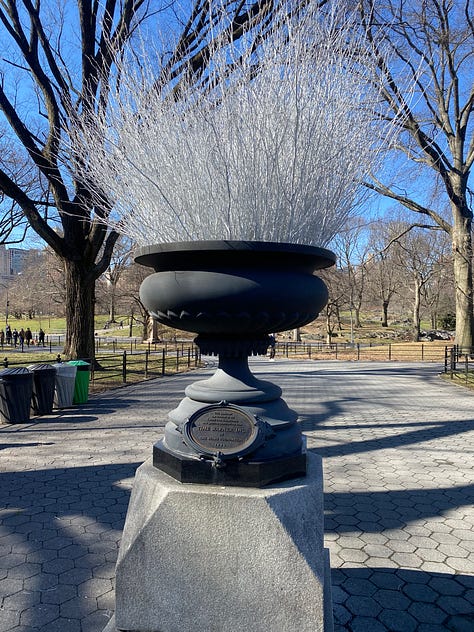

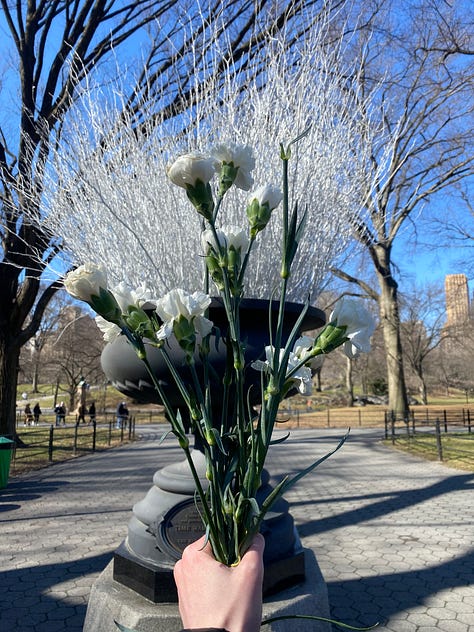
Whenever I go somewhere with Pascal, an element of whimsical magic and surrealism seems to find us. Pascal is bright and curious like a story book character, and will always be the first to pull at a loose thread to see where it leads him.
We decided to leave the bandshell just moments before 12pm, with the mission to bring our flowers to Strawberry Fields to lay down on the Imagine circle as a postcard for Yoko. As we walked West across the park, we noticed a small group of what seemed to be birders, looking upwards towards the trees, some with binoculars in hand.
Pascal was the first to rush over quickly and ask them to explain. Someone gave a few story details and pointed to a spot hidden among the high branches. Pascal found immediately what they were watching. It took me a few extra minutes, but then I saw, too. It was Flaco.
We stood among this small group and watched in silence and awe. No one said anything, partially not to disturb him, and also just lost in peaceful amazement, each of us held within our own personal moments of appreciation and gratitude. It was beautiful and quiet. At 12:09 I took a picture of Flaco.
It seemed unreal that we had come across him in this particular moment, on our way through the park with flowers for Yoko. The flowers were for of course Yoko, for Imagine, and also they were for Flaco. Flowers for everyone. They were flowers for Peace. We stayed for about 10 more minutes, and then we made our way to Strawberry Fields, where I was able to lay down the flowers, a gesture of closure for our adventurous day.

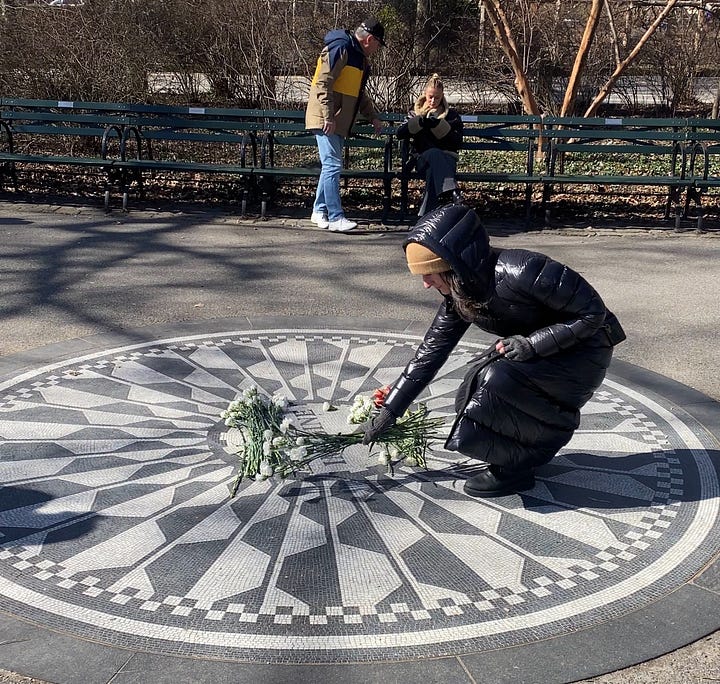
I feel very blessed that I was able to see Flaco with my own eyes and stand there breathing in his great presence. I was able to see him perched still and peacefully, and also I was able to see him fly away, disappearing into the distance. I wish I could print that memory onto film and watch it, his dark wings against the white sky so clear in my mind, making their way towards the next thing.
I looked up the lifespan of a Eurasian Eagle Owl, and read that ‘Once they reach adulthood, Eurasian eagle owls are relatively long lived, typically reaching 20 years in the wild and up to 60 years in captivity.’ Flaco of course was only 13, a lucky number associated with the divine, or a cursed one, depending on who you’re asking and when.
In Flaco’s memory, I’ll share a few stories and some favorite resources with you. I hope you will share yours too, in the comments.
One of the greatest influences in my life has been the great writers and thinkers of Concord, Massachusetts, in particular Mr. Henry David Thoreau. At another point, they and he will have a dedicated post, but for today we’ll talk more about the birds of Concord, which I’m more than sure Henry would be pleased about.
The Thoreau Society Annual Gathering, which takes place every July in Concord around Henry’s birthday (July 12), is a dear favorite activity of mine. In 2022, I was invited to hold my own concert as part of the calendar of events, and for me, this was a pivotal life moment. The people I met during this time influenced and changed my life in such beautiful ways, and I truly look up to them as both teachers and guides, and also as friends. Learning about our woodlands with Andrew Joslin (lovingly referred to by some as ‘Andrew of the Tree Tops’), learning about the vast world of lichens from Kay Hurley. Learning to identify birds and trees, specimens and insects from both of them. This whole trip was deeply special to me. Singing a full night of my songs for the first time. Getting my first tick bites. Kayaking Thoreau’s waters. Meeting Jane Goodall. It was one of those truly profound weeks in our lives that we continue to draw from as the years continue.
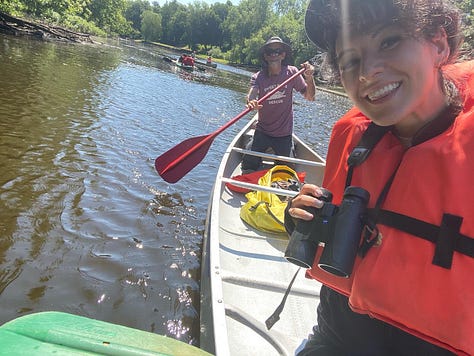
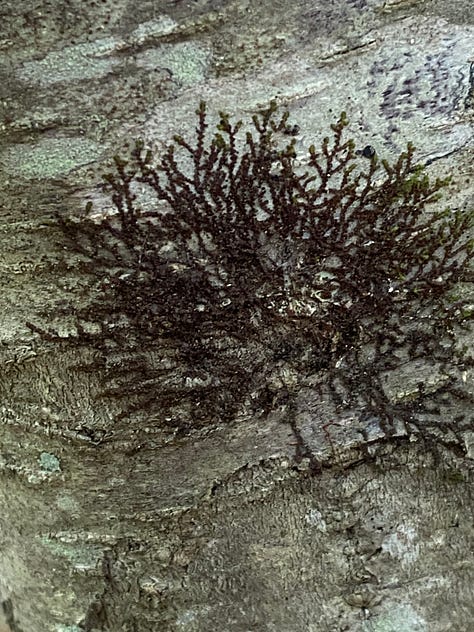
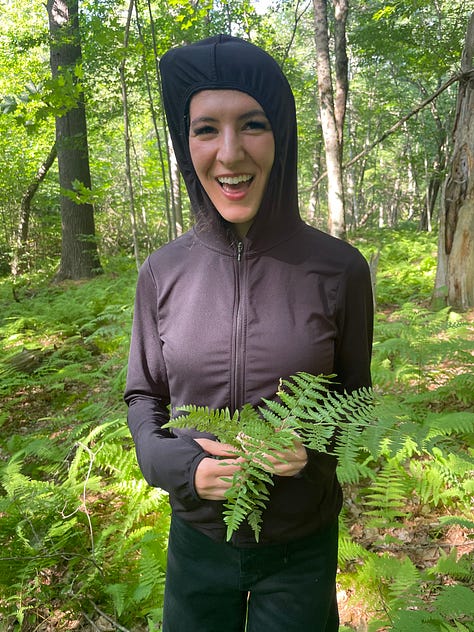
On the last day of the gathering, Peter Alden, a beloved birding expert, held a small celebration at his local home. I had been an admirer of Peter’s for many years, having bought a birding guidebook from him at signing in 2017. I loved his wit and dry humor, and was amazed by his knowledge and ability to identify seemingly any bird from their voice or image. Gathering at his home, he brought us all on a birding walk, pointing out the recognizable feathered friends of Concord. It was on that walk that he suggested we download the Merlin Bird ID App, a global guide and bird identification app created by Cornell University. Heading back to his house, Peter showed us his archives and collections of images, organized in the most incredible way in his endless library of filing cabinets and flat files. I was eager for a book and he signed one for me, Finding Birds Around the World by Peter Alden and John Gooders.
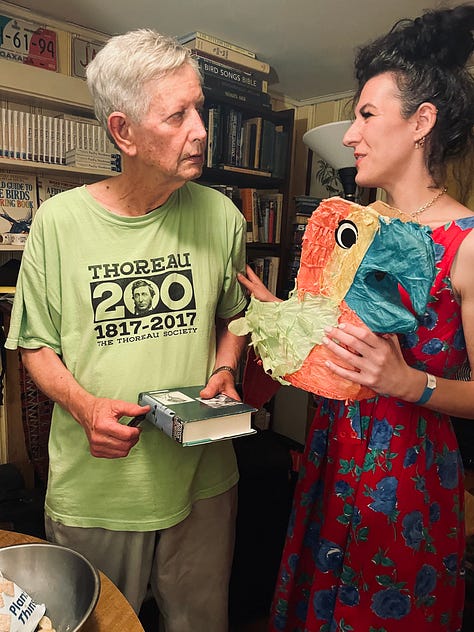
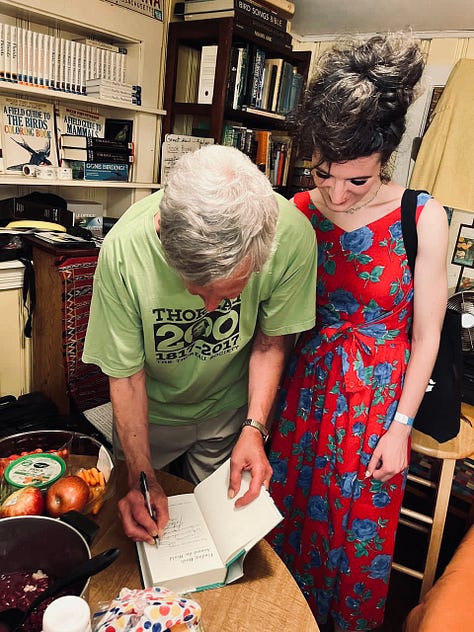
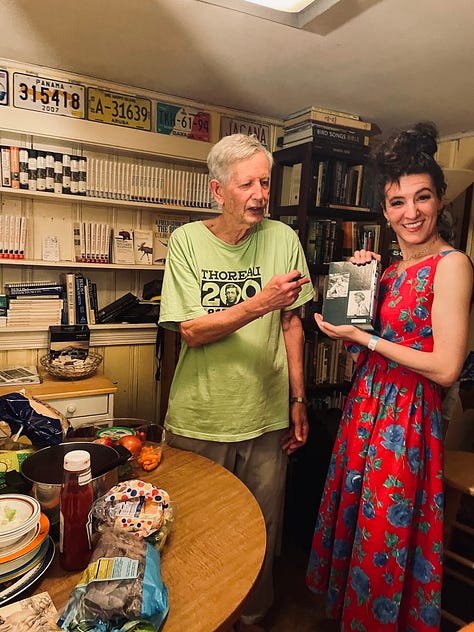
I took the train back to NYC, and stayed in touch with Peter, and with Andrew, and with Kay. With all of my new Concord friends. I had downloaded the Merlin App, too, and it became a favorite activity to take to the park on a quiet morning, learning to identify the singing and calls of the birds nearby. The first time I recognized a new one on my own was one of those beautiful moments where the wildness of nature feels a little less separate and a little more like home, the way it did when we were kids, the way it should be, that so often gets away from us today.
On July 21, sitting on the couch in my apartment I noticed a strange sound which seemed to be coming from the fireplace. I wasn’t sure what it was, maybe something in the chimney, on the roof. It wasn’t a sound I had heard before, and I couldn’t tell if it was a person repairing something in the building, an animal sound, or something else. It took a while for the idea to flash in my mind, but suddenly it became so obvious - there was a bird in the chimney!
I listened for a while longer and eventually reached out to the Wild Bird Fund, alerting them to ‘long periods of silence, then a lot of activity of fluttering and motoring wings, with occasional scratching.’ I also called Andrew of the Tree Tops, who was kind and supportive to the task. It was suggested at first to be a chimney swift building a nest, but the sounds were too frantic to be a nesting mother focused on a task, and more like the panic of distress and extreme duress. It took some brainstorming, and eventually realized it would be necessary to open the chimney flue, help the bird get into the apartment, and find a way to free them outside. We didn’t want the bird to have too much longer of a period of feeling trapped and scared, and as short a time as possible enduring a new level of panic trying to find an escape exit within the apartment. So we put a cardboard box with seeds in the fireplace, made a plastic wall over the opening from clear recycling bags and blue tape, and opened the flue. It took a while, but on July 22, the bird hopped into the box to get the food. We immediately removed the plastic shield, closed the box, and took it outside onto the stoop. Facing the box towards the trees, I opened the lid, and the bird gently flew in an upwards trajectory and perched on one of the branches. We looked at each other for a few moments in silence, and the little bird flew away, maybe towards the park.
This was a magical story. I truly felt that after my trip to Concord and my newly formed attachment to the Merlin app, the bird must have known this was a friendly home. I wrote to Peter Alden and told him how I handled the dilemma. Andrew was proud of the success and happy for our bird friend. Watching the video in slow motion, the little bird appears to be a first year/juvenile Starling just fledged, Andrew of the Tree Tops suggested. Gathering the cardboard box for recycling, I looked down and noticed a bluejay feather on the ground which must have come from the one who shouts his call every day from the tree the bird flew up to, the tree just outside the apartment window. A little gift for the actions of the day. :)
I’ve always loved birds. A fascination and deep appreciation for their songs, for the life and freedom they represented, for flying and gliding, for building nests with great care and traveling across the world in packs. For their exquisite formations, the color spectrum of their eggs, the elaborate or humble costuming of their feathers, their eyesight and demeanor. The world they see that we can never know. I love how birds have been celebrated and depicted through time. Audubon watercolor paintings, guidebooks from centuries past. I have binoculars, and admire the dedication and patience of birders. When I was around 20, I went through a time when I would draw 1 bird every day. I would trace them lightly from a scene in a guidebook, and spend some time with colored pencils bringing the being to life. It was a nice meditation for me, and I grew a little collection of drawings and favorite clipings, recognizing the ones that touched my heart the deepest - shore birds running wildly along the water’s edge, and the birds from my childhood whose voices were the soundtracks for some of my most freeing moments of life.
I always admired this winged world from afar, though it was on that trip to Concord and Carlisle in 2022 that the appreciation was raised to a new level. I realized when the Starling was trapped in the chimney that birds are sort of like the ocean, seemingly gentle and also quiet majestic in power. A distant bird song from the trees can lull you into dreams like the waves on a beach, but flying is vast as the horizon, and a bird flapping wildly, trapped inadvertently in a New York City apartment is like waves crashing violently against the rocks. There is tenderness and danger, coexisting in a strange harmony, and we must proceed with caution and respect.
On the morning of September 27, 2023, just 4 days after our sweet Cairo died, I was walking down 81st street on my way to the subway, just across from the American Museum of Natural History. There was a construction crew working on a building under scaffolding, and I spotted what appeared to be a little green bird figurine or toy, perched on some construction material on the sidewalk. I passed by quickly, thinking it was rather funny and strange for this little toy to be sitting there. I wondered who it belonged to, who was missing it. I stopped and turned around, my brain struggling to fit this image into concrete logic, and walked back towards it, staring, trying to decipher if it was real or imagined. As I got closer I realized this little bird was in fact real, alive, and seemingly stunned or injured. After a few moments of quiet eye contact, I reached my hand out, and without any resistance whatsoever, the little bird allowed me to pick it up and hold it in my open hand. The construction crew said they originally found it sitting in the middle of the sidewalk and they moved it onto the material to keep it safe. I told them I would bring the little being to the Wild Bird Rescue and they were happy.
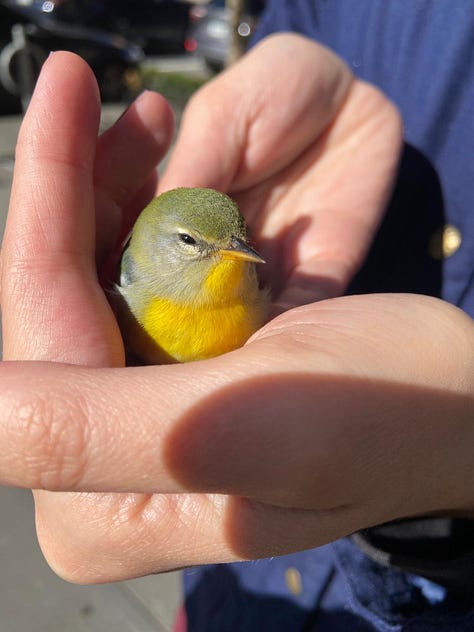
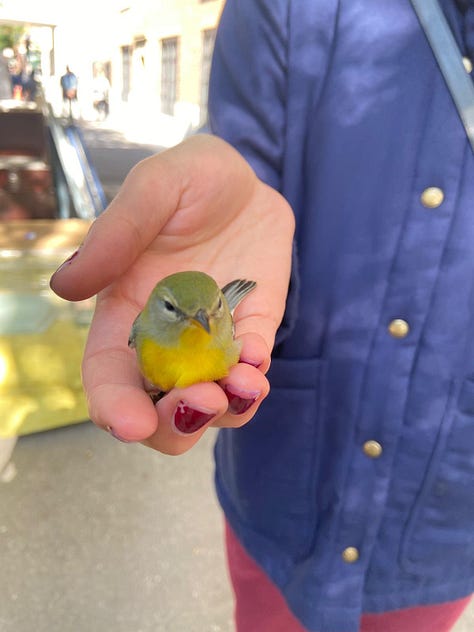
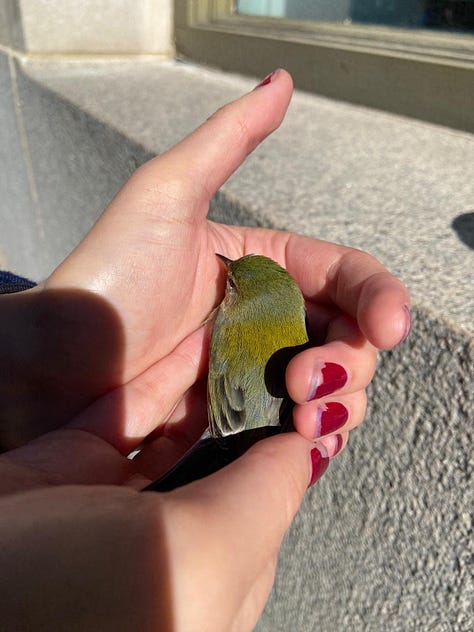
Carrying this sweet and tender little friend down the street on the palm of my hand, just a few days after our loving and gentle Cairo had died, it felt like this little green creature was like a visitor from another planet or dimension, a messenger sent down from Cairo, or maybe even Cairo herself, momentarily taking on another form to deliver a note, letting us know she was okay, that she loved us dearly, to say anything and everything she wanted to. I brought the little bird to the Wild Bird Fund, filled out some paperwork, and said goodbye. Goodbye, little friend.
When I got home just half an hour later, I found four yellow flowers and a small cat figurine someone had left on the stairs, a condolences blessing for Cairo. Yellow flowers like the belly of the bird.
Thinking of these little friends who pass us by throughout life, in flight or injury, perched watchfully in the trees like Flaco, or waiting for us patiently on a piece of construction material, birds are always teaching us some form of lesson, without push or effort, simply by being. In my song, Legacies, the last lyric says, ‘No one will remember us, cause legacies mean nothing to birds in the sky.’ It might seem sad, and it sort of is, though it is also meant to be freeing. Legacy, the desperate need to make our mark, is both our great blessing and curse as human beings. We would love to be the ones who did great things, the ones who were the positive catalyst for change, the ones whose songs and words ignited action, helped lonesome souls discover the courage to fall in love unexpectedly, and soothed the hearts of those most grieving. In the end, we can still remember to be like the birds, existing freely as freedom is their great badge, effortlessly carried by the wind if they are lucky to be alive. I would like to be like a human and a bird, aware of my legacy and the mark I can make while I am here, and untethered by the fear of how that may be perceived in the future, as the ideas of others are out of our hands, and all we can do live in our own truth, with our highest intentions, doing our best while we are alive. It’s amazing how Flaco’s legacy is so alive today, his name passing in sound through conversations of New Yorkers across the city, and those learning about him only in his death, telling stories of his life, asking friends if they had ever seen him or heard him. I wonder if Flaco knew his own name, and if in the birdly heaven he is flying free and ageless. Let’s honor his legacy with the patient kindness of a birder, and let’s continue to give love and attention to our neighboring birds as that same admiration was given to Flaco. Let’s be aware of the chance we have right now, here on earth together, and the legacies we are leaving. Let’s share afternoons and evenings with friends spontaneously, and let’s keep the memberships alive for the friends who departed us too soon.
In Loving Memory of Flaco
Written on February 25, 2024
Resources and Links - birds, birders, bird rescue, and birdwatching
Beloved Birders <3
Peter Alden
Peter Alden is a world renowned naturalist, lecturer, ecotourism guide and author of 15 books on North American and African wildlife, including the National Audubon Society’s Regional Field Guide Series. He is considered to be an authority on birds and larger mammals of the world and is often consulted by the media and the ecotourism industry for his expertise. Peter is also a highly entertaining and widely sought after lecturer on topics that include world wildlife, the Polar regions, invasive plants and biodiversity of the northeast.
Interview with Concord Library
Heather Wolf
Heather is an avid birder, photographer, and author of Birding at the Bridge: In Search of Every Bird on the Brooklyn Waterfront. She leads bird walks in Brooklyn Bridge Park and shares her photos of the park’s birds on her blog, Beyond Brooklyn, Heather is a naturalist lecturer on cruise ships, where she generates excitement about topics including bird migration, Caribbean birding hotspots, mollusks and manatees.
If you aren’t already following Chloe’s Substack, I highly recommend it. Here is an appropriate post to share in memory of Flaco:
And her very first post which describes more about her work and ideals:
Two great Substack writers to follow focused on Birds and Nature
This Week in Birding on Substack with Bob Dolgan
Chasing Nature on Substack with Bryan Pfeiffer
Articles in Memory of Flaco
Petition to erect a statue of Flaco in Central Park
Organizations and Guide Resources
Please share any other resources or information in the comments. Thank you <3


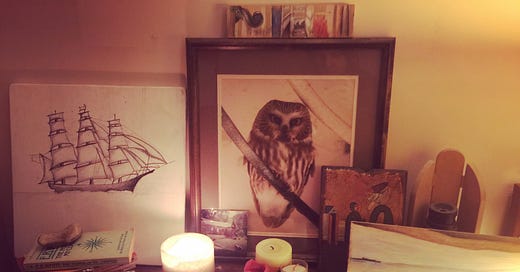



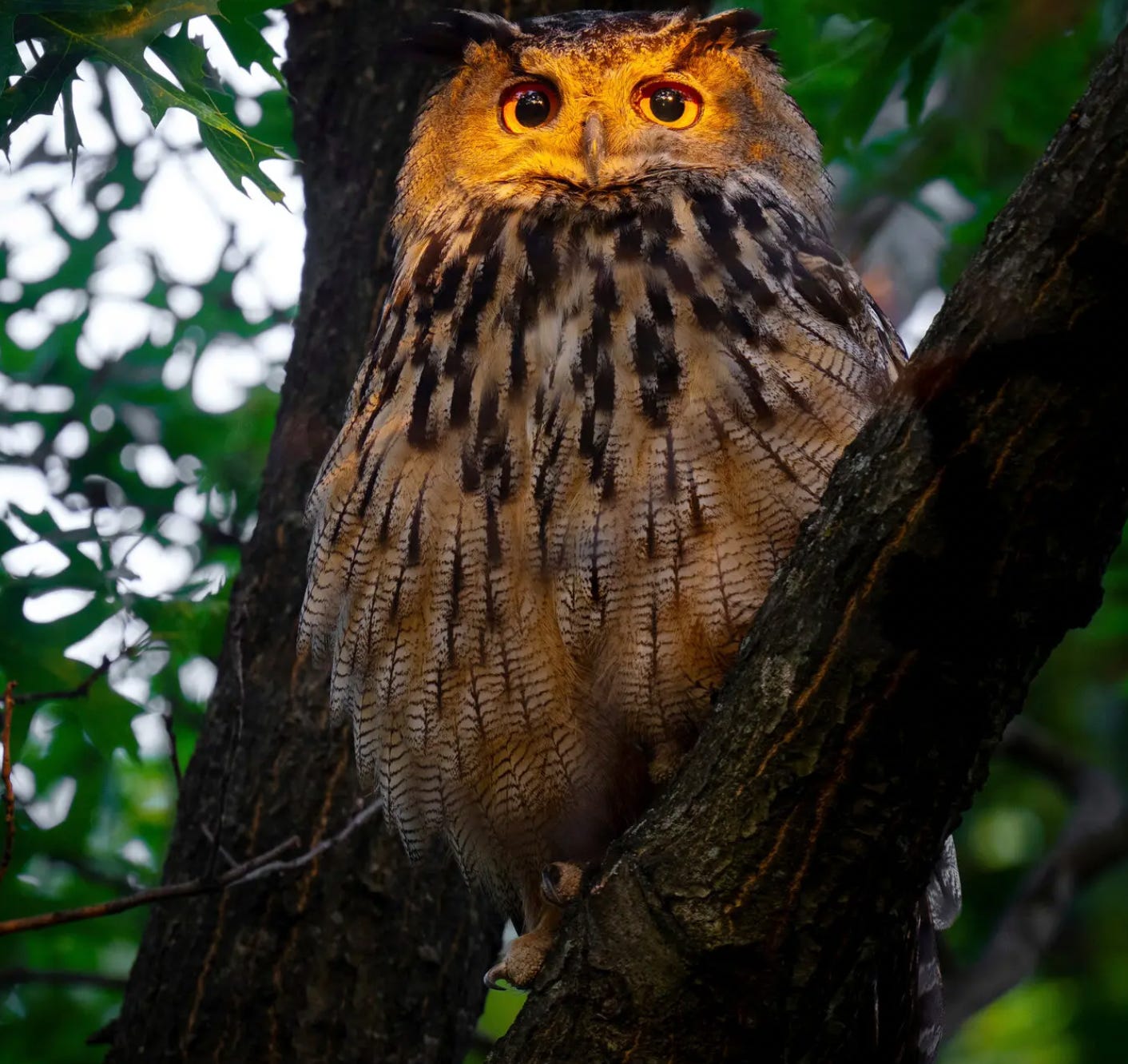
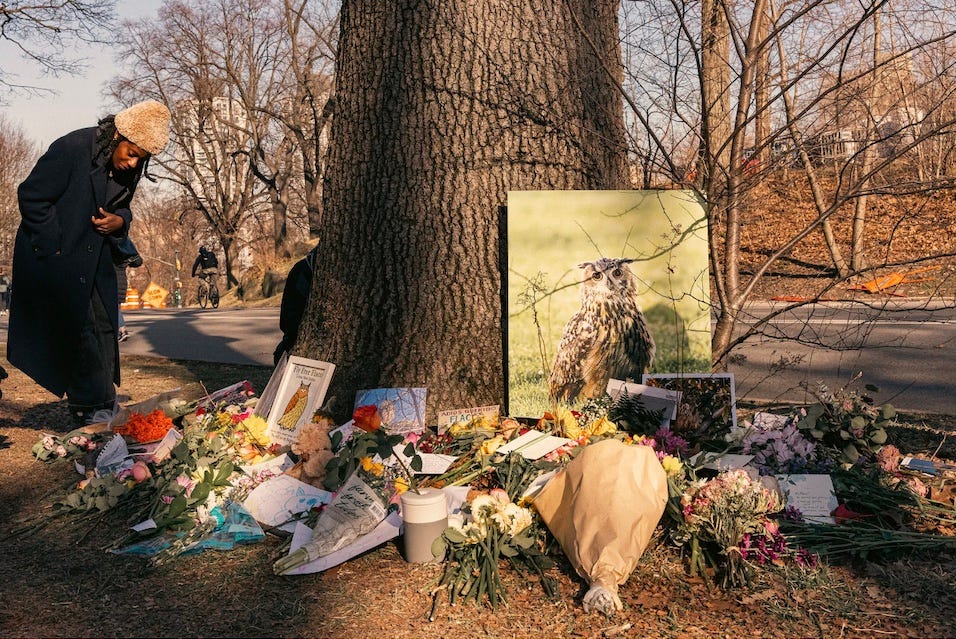
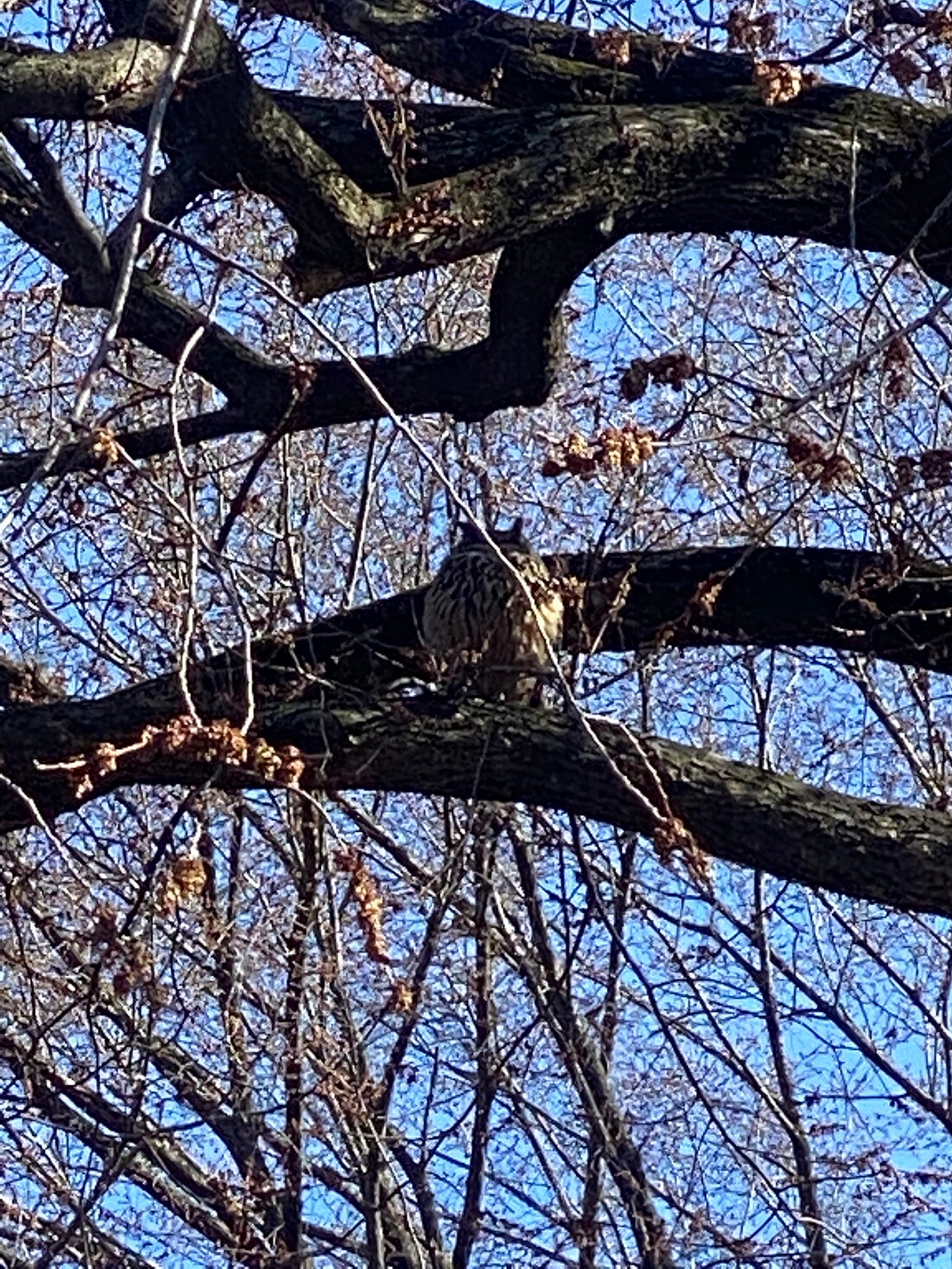


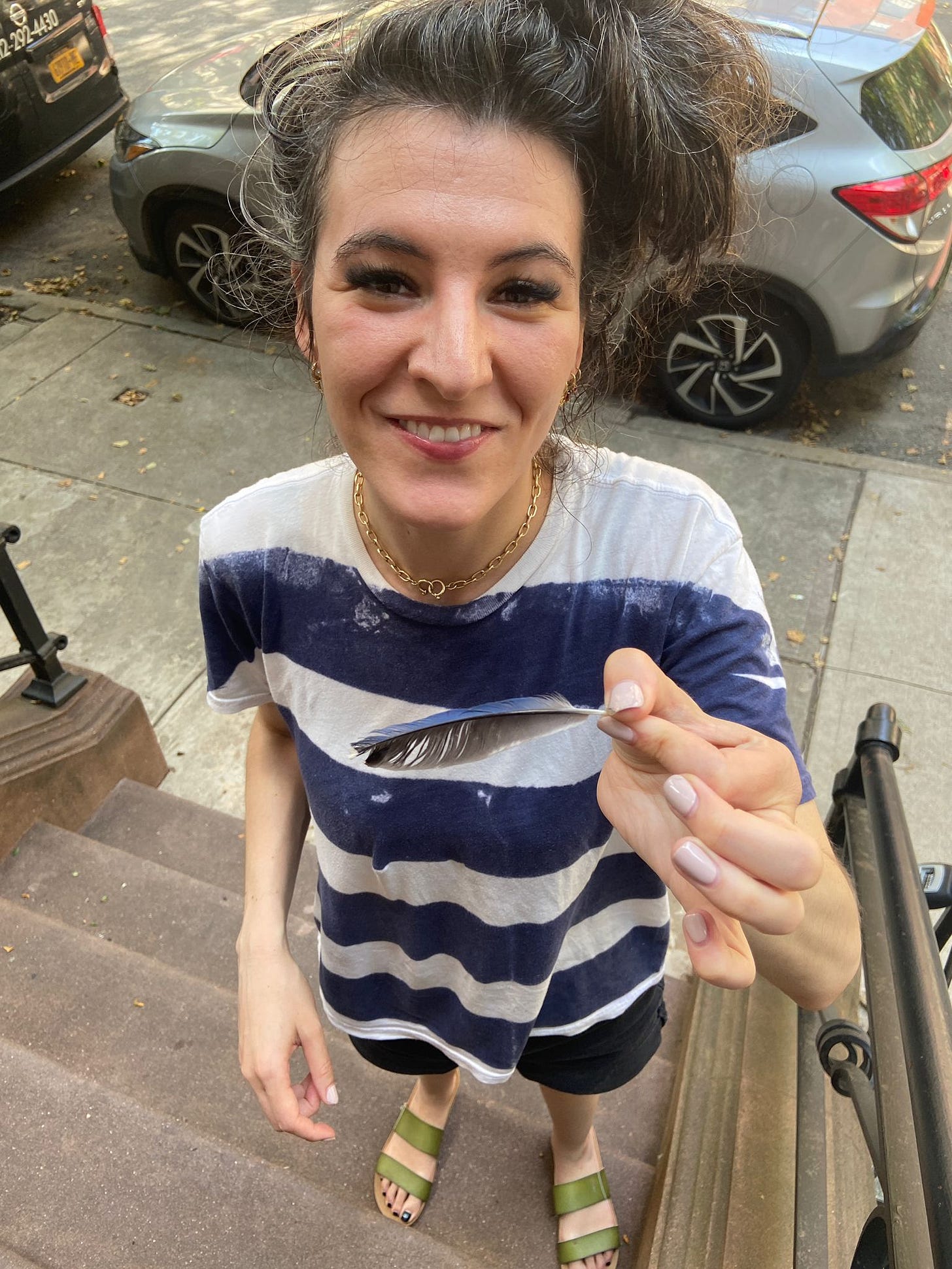
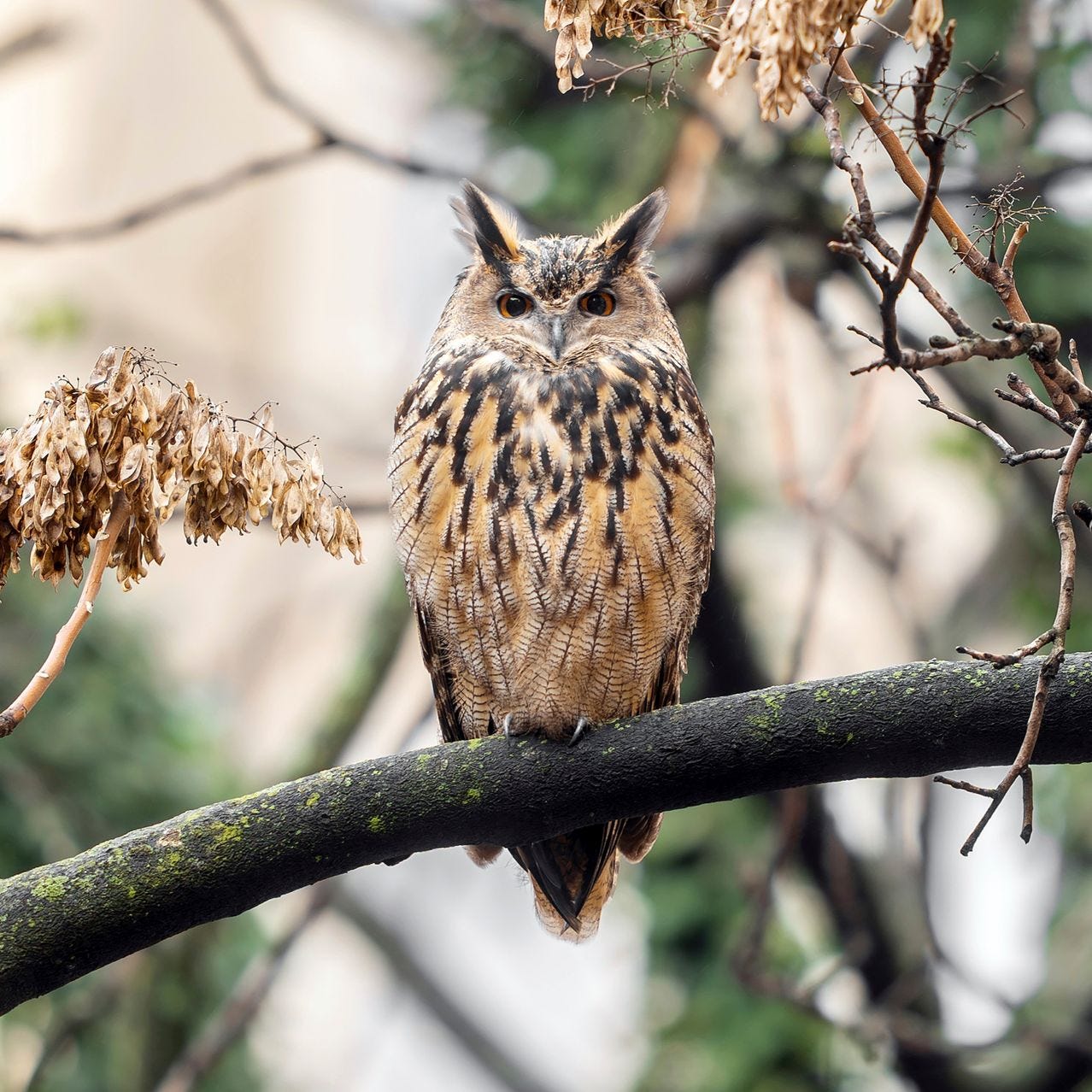

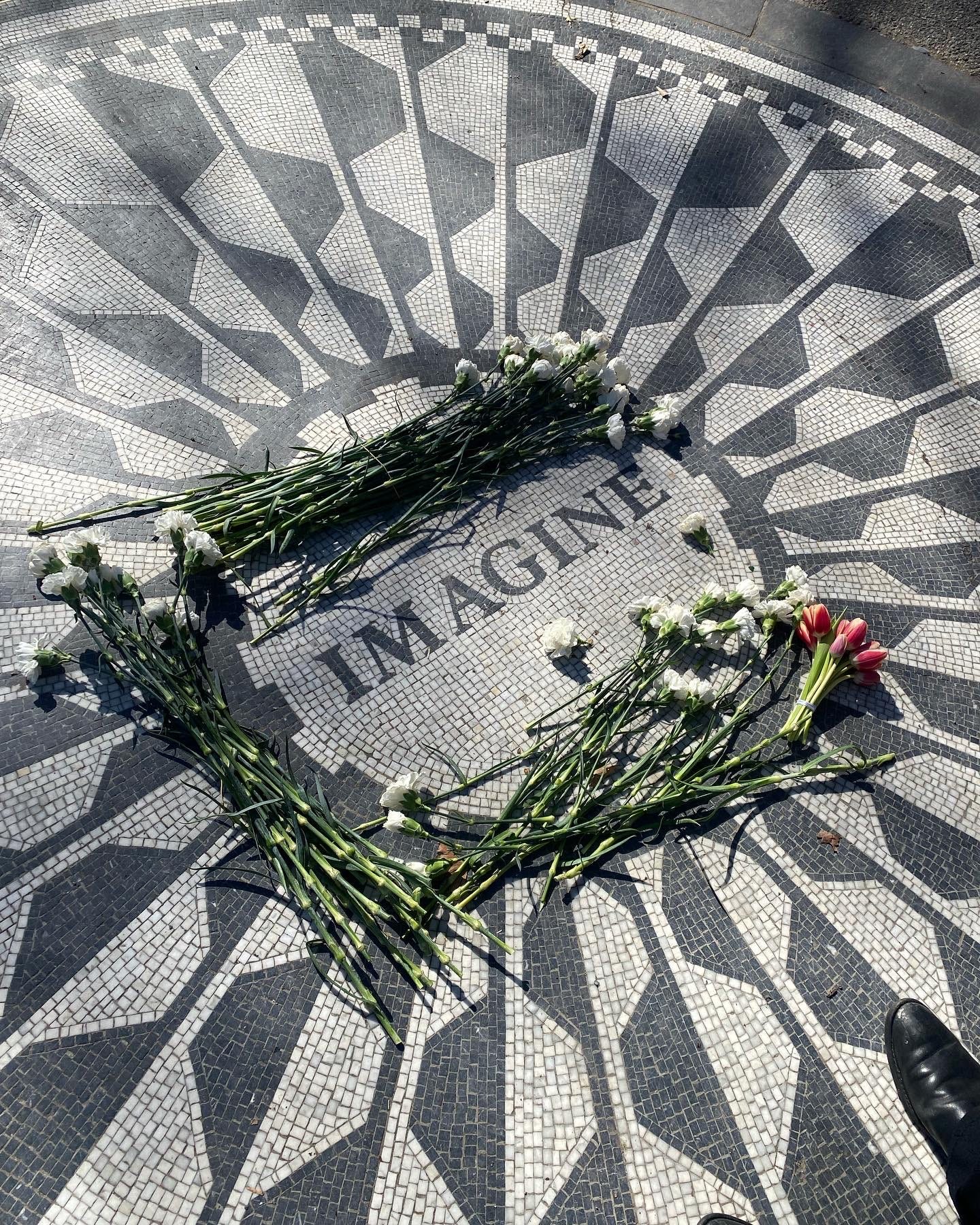
Pinning this petition that Lee Penman brought to our attention. Sign on to support a statue of Flaco in Central Park! <3
https://www.change.org/p/erect-a-statue-in-central-park-honoring-flaco-the-escaped-eurasian-eagle-owl
Beautiful tribute to Flaco. May his memory be a blessing. Thank you for sharing your own meeting of this special bird being who has done so much, through his freedom and even through his sacrifice, to open the hearts and minds of people throughout NYC and the whole world. I’ve also studied with Dr Jane Goodall. She taught us that animals have messages for us if we learn to listen to them. Clearly you are wonderfully sensitive to this, to listening and learning. Thank you for sharing your messages from Flaco, from birds, from Cairo. As for the Merlin app itself, it’s a great tool. Among my recent id’s are song sparrows, Bewick’s Wrens who are hard to see but have a sweet little song, and the eponymous Merlin. Thank you so much for a great post.